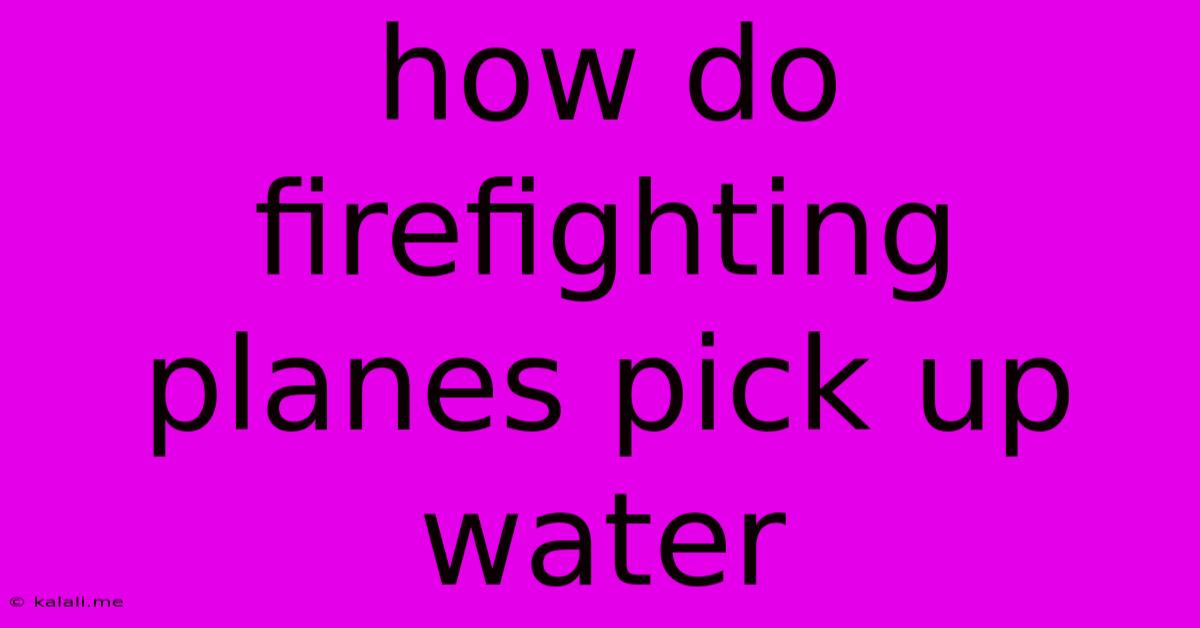How Do Firefighting Planes Pick Up Water
Kalali
May 31, 2025 · 3 min read

Table of Contents
How Do Firefighting Planes Pick Up Water? A Deep Dive into Aerial Fire Suppression
Air tankers and other firefighting aircraft play a crucial role in combating wildfires, especially large and rapidly spreading blazes. But how do these impressive machines actually pick up all that water (or fire retardant)? It's a process that's more sophisticated than you might think, varying depending on the type of aircraft. This article will explore the different methods used for water collection in aerial firefighting.
Understanding the Different Types of Firefighting Aircraft
Before diving into the water pickup methods, it's important to understand that not all firefighting aircraft are the same. There are three main categories:
- Air Tankers: These are large, purpose-built aircraft specifically designed for aerial fire suppression. They carry significant amounts of water or retardant and are often modified versions of existing airframes.
- Helicopters: Helicopters offer maneuverability and precision, making them ideal for attacking smaller, more difficult-to-reach fires. Their water collection methods differ significantly from air tankers.
- Amphibious Aircraft: These unique aircraft can land and take off from both land and water, allowing them to refill directly from lakes and rivers.
Water Scooping Techniques: The Dramatic Dip
The most visually striking method is water scooping, primarily used by amphibious aircraft and some specially equipped helicopters. This involves skimming the surface of a water source—a lake, river, or even the ocean—at low speed to fill onboard tanks.
- The Process: The aircraft approaches the water at a carefully calculated speed and angle. A scoop or water intake system, often located under the fuselage, dips into the water. The water flows into the tanks, usually through a series of filters to prevent debris from entering. The process is remarkably efficient and quick, enabling rapid refills.
- Aircraft Examples: Canadair CL-215 and CL-415 are prime examples of aircraft designed for water scooping, renowned for their efficiency and speed.
Water Bombing: Refilling from the Ground
This method is the most common for air tankers and many helicopters. Instead of scooping water directly, these aircraft refill from a base of operations on the ground.
- The Process: A network of specialized fire fighting bases are established near the fire. These bases have large water tanks and sophisticated pumping systems. The aircraft lands or approaches a designated area where ground crews quickly fill the tanks. This method requires more time for refueling, but allows for greater water capacity than scooping.
- Ground Support: This process relies heavily on efficient ground crews. The speed and accuracy of ground refueling heavily influence the overall efficiency of firefighting operations. They carefully monitor water levels and ensure a smooth and safe refill process.
Helicopter Bucket Systems: Precision and Versatility
Helicopters often utilize a bucket system, a large, durable bucket suspended below the aircraft. This bucket is lowered into a water source (lake, river, pond, even a swimming pool!), filled, and then lifted back up.
- Precise Deployment: Helicopters offer superior maneuverability, making them adept at accessing smaller water sources inaccessible to larger aircraft. They can often use a more targeted approach to firefighting, using the bucket to directly douse flames.
- Versatile Choices: They may also utilize other methods like flexible tanks that allow them to pick up water from reservoirs.
Fire Retardant Delivery: Beyond Water
While water is a primary extinguishing agent, many air tankers and helicopters also deliver fire retardant. This substance isn't scooped or filled like water; it's loaded at the base of operations into specially designed tanks within the aircraft. Fire retardant helps slow the fire’s spread, giving ground crews more time to effectively contain the blaze.
In conclusion, the methods for firefighting aircraft to pick up water are varied, depending on the specific type of aircraft and its capabilities. From the dramatic water scooping of amphibious aircraft to the efficient ground refueling of air tankers and the precision of helicopter bucket systems, each method plays a critical role in effective aerial fire suppression. Understanding these techniques provides a deeper appreciation for the complex and coordinated effort required to combat wildfires.
Latest Posts
Latest Posts
-
Where Is Paradise That Jesus Spoke Of
Jun 01, 2025
-
What Does Answered Remotely Mean On Samsung
Jun 01, 2025
-
How To Pluralize A Last Name Ending In Y
Jun 01, 2025
-
How Long Does It Take For Chocolate To Harden
Jun 01, 2025
-
Best Placement For Bathroom Exhaust Fan
Jun 01, 2025
Related Post
Thank you for visiting our website which covers about How Do Firefighting Planes Pick Up Water . We hope the information provided has been useful to you. Feel free to contact us if you have any questions or need further assistance. See you next time and don't miss to bookmark.